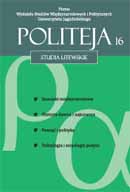Status polityczny i prawny dowództwa litewskiej partyzantki w latach 1944-1953
Political and legal status of Lithuanian underground movement in 1944-1953
Author(s): Bernardas GailiusSubject(s): Politics / Political Sciences
Published by: KSIĘGARNIA AKADEMICKA Sp. z o.o.
Summary/Abstract: Historically the Lithuanian guerrilla war against the soviet occupation embraces the period from 1944 to 1953 and is divided into three stages: 1944-1946; 1946 -1948 and from 1949 onwards. The question of the leadership was important throughout the history of the guerrilla war. Not only the commanders of the guerrilla fighters, but also the organizations of the émigrés as well as the diplomatic corps thought of themselves as the representatives of Lithuania. However, it was the partisans who were actually fighting the occupants and who therefore were in the closest relationship with the political nation – the undoubted bearer of the sovereignty according to the contemporary worldview. Therefore, to the leadership of the guerrilla movement belonged not only the military, but also the political authority in the occupied Lithuania. If the guerrilla war is interpreted according to the concept of Carl Schmitt, its relation to the political nation becomes apparent. It takes little effort to see in “the defensive-autochthonous defender of home” the modern citizen par excelence – the one who is ready to take up arms in defense of his fatherland. However, this interconnection escaped the attention of Carl Schmitt himself. Therefore “The Theory of Partisan” was left independent of the Carl Schmitt’s concept of the sovereignty (“Sovereign is he who decides on the exception”). But if the guerrilla war is considered as itself the state of exception, it opens the way for the qualitatively new theory. The most visible and practical appearance of the European national sovereignty was the revised concept of citizenship. It became some kind of political kinship. The only known earlier model of such political community was the ancient republic of Rome. The Roman precedent of the guerrilla war was known as iustitium – the ancient concept of the state of exception, recently revised and reconsidered by Giorgio Agamben. Although it could acquire different military forms, politically it always meant the same phenomenon – the direct exercise of the governmental power (imperium) by the ordinary citizens. In turbulent times they were empowered to take any steps necessary for the salvation of the republic. The same practical enactment of the national sovereignty forms the essence of the modern guerrilla war. However, the partisan is not only the “autochthonous defender”, but also a political figure. In modern times (as opposed to the ancient Rome) he does not identify with the established political order. The historical analysis provides that the partisan of the 19th and the 20th centuries not only defended his homeland, but also sought the renewal of the political regime. Therefore, he embodied the creative as well as the conservative aspect of the sovereign power belonging to the political nation.
Journal: Politeja - Pismo Wydziału Studiów Międzynarodowych i Politycznych Uniwersytetu Jagiellońskiego
- Issue Year: 8/2011
- Issue No: 16
- Page Range: 207-228
- Page Count: 22
- Language: Polish

